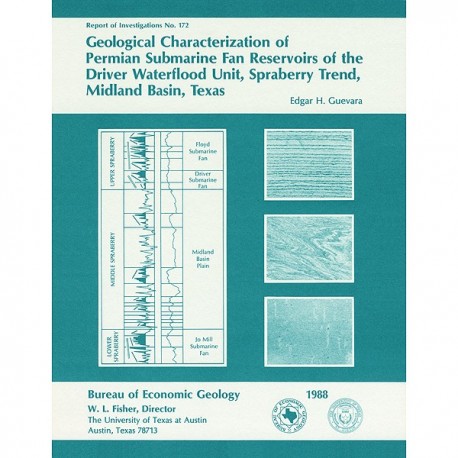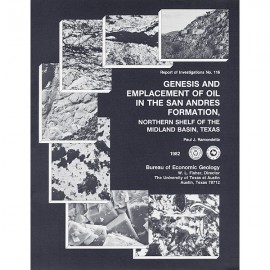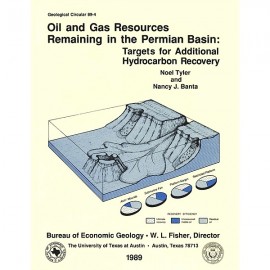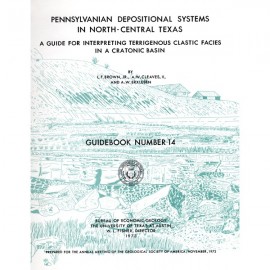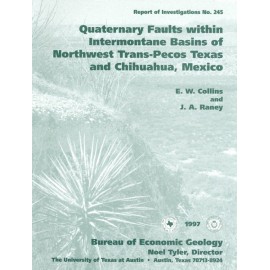Reports of Investigations
-
Books & Reports
- Reports of Investigations
- Guidebooks
- Udden Series
- Geological Circulars
- Down To Earth
- Atlases of Major Oil and Gas Reservoirs
- Texas Memorial Museum Publications
- Environmental Geologic Atlas of the Texas Coastal Zone
- Mineral Resource Circulars
- Other Reports
- Seminars and Workshops
- Handbooks
- Submerged Lands of Texas
- Symposia
- Annual Reports
- Open File Reports
-
Maps & Cross Sections
- Thematic Maps
- Miscellaneous Maps, Charts & Sections
- Geologic Atlas of Texas
- STATEMAP Project Maps
- Geologic Quadrangle Maps
- Cross Sections
- Highway Geology Map
- Energy and Mineral Resource Maps
- Shoreline Change and Other Posters
- Wilcox Group, East Texas, Geological / Hydrological Folios
- Bouguer Gravity Atlas of Texas
- River Basin Regional Studies
- Featured Maps
- Posters
- Teachers & the Public
-
Geological Society Publications
- Gulf Coast Association of Geological Societies
- Alabama Geological Society
- Austin Geological Society
- Corpus Christi Geological Society
- Houston Geological Society
- Lafayette Geological Society
- Mississippi Geological Society
- New Orleans Geological Society
- South Texas Geological Society
- GCS SEPM Publications
- Historic BEG & UT Series
Geological Characterization of Permian Submarine Fan Reservoirs of the Driver Waterflood Unit, Spraberry Trend, Midland
RI0172
For a downloadable, digital version: RI0172D.
RI0172. Geological Characterization of Permian Submarine Fan Reservoirs of the Driver Waterflood Unit, Spraberry Trend, Midland Basin, Texas, by E. H. Guevara. 44 p., 28 figs., 3 tables, 2 appendices, 1988. ISSN: 0082335X: Print.
To purchase this publication as a downloadable PDF, please order RI0172D.
ABSTRACT
More than 350 well logs and core and production data were used to geologically characterize oil reservoirs of the Driver waterflood unit of the Spraberry Trend in the Midland Basin, West Texas, and to assess the relationship between reservoir stratigraphy and oil recovery. Results of this research indicate that to improve oil recovery from the Driver unit, and from the Spraberry Trend in general, selection of completion intervals and strategic infill drilling locations should be determined by both reservoir stratigraphy and natural fractures.
Fifteen log-defined genetic-stratigraphic operational units composed mainly of sandstone and siltstone were delineated in the approximately 1,000-ft- (305-m-) thick, predominantly shale and carbonate Spraberry Formation of Permian (Leonardian) age. Sandstone and siltstone of this lithostratigraphic unit accumulated in submarine fans, forming upward-thickening sequences in the lower (Jo Mill submarine fan system) and upper (Driver and Floyd submarine fan systems) Spraberry. Areas of Spraberry submarine fans having greater net thickness of sandstone and siltstone form NNW- to NNE-trending belts. These sand-rich areas contain the main oil reservoirs of the Driver unit; they consist of low-permeability (less than 1 md), low-porosity (less than 8 percent to approximately 14 percent) sandstones and siltstones capping submarine fans of the lower and upper Spraberry.
Historically, selection of well locations and completion intervals in the Driver unit has been based on the assumption that oil production is largely controlled by natural fractures in homogeneous, laterally extensive, sheet-like reservoirs. However, production data show trends that are generally correlative with axes of maximum sandstone and siltstone in operational units, suggesting that reservoir stratigraphy strongly influences oil production. Complex facies architecture of Spraberry reservoirs produces vertical and horizontal reservoir heterogeneity. Stacking of submarine fans results in multilayered, or stratified, oil accumulations in which reservoir rocks are separated vertically by shales and carbonate mudstones. Oil accumulations are also laterally compartmentalized because the main reservoirs occur in sand-rich belts generally parallel to the basin axis.
The current low recovery efficiency of approximately 10 percent is attributed to reservoir heterogeneity that results in incompletely drained hydrocarbon zones. In performing well recompletions and strategic infill drilling, operators must consider stratigraphic heterogeneity in order to produce oil from untapped or only partly drained reservoir compartments. New well logs and core are necessary for identification and characterization of oil-saturated zones and natural fractures. These reservoir management strategies are also applicable to similar oil reservoirs, such as the Dean Sandstone of the Midland Basin.
Keywords: Driver waterflood unit, Midland Basin, naturally fractured reservoirs, Permian, reservoir heterogeneity, reservoir stratigraphy, Spraberry Formation, Spraberry Trend, submarine fans, Texas
CONTENTS
Abstract
Introduction
Methodology
Paleogeographic Setting
Stratigraphy of the Spraberry Formation
Depositional Systems in the Driver Unit
Facies tract and depositional model
Jo Mill submarine fan system
Driver submarine fan system
Floyd submarine fan system
Sediment Dispersal System
Hydrocarbons in the Spraberry Formation
Influence of natural fractures on oil production
Hydrocarbons in the Driver Unit
Stratigraphic control of oil accumulations
Porosity, permeability, and oil-producing intervals
Stratigraphic heterogeneity of Spraberry reservoirs
Influence of reservoir stratigraphy on oil recovery
Reservoir stratigraphy and waterflood flow paths
Opportunities for additional oil recovery
Acknowledgments
References
Appendix A. Methodology
Appendix B. Development ofthe Spraberry Trend and the Driver unit
Figures
1. The Midland Basin and principal Spraberry oil fields
2. Principal Spraberry waterflood units, central Midland Basin
3. Subsurface control and index of cross sections. Driver unit
4. Stratigraphic subdivisions of the Spraberry Formation. Driver unit
5. Stratigraphic cross section A-A'. northern part of Driver unit
6. Stratigraphic cross section B-B', western part of Driver unit
7. Facies tract, upper Spraberry submarine fans. Driver unit
8. Core from Jo Mill submarine fan system (lower Spraberry), Sun Oil Company Jalonick No. 2 well
9. Net thickness of sandstone and siltstone. operational unit 2L, Driver unit
10. Log facies map, sandstone zone s, operational unit 2L, Driver unit
11. Core from upper Spraberry submarine fans, Sun Oil Company Jalonick No. 1 well
12. Net thickness of sandstone and siltstone, operational unit 5U, Driver unit
13. Log facies map, sandstone zone f, operational unit 5U, Driver unit
14. Net thickness of sandstone and siltstone, operational unit 1 U, Driver unit
15. Log facies map. sandstone zones b-c, operational unit 1U, Driver unit
16. Stratigraphic cross section C-C', constructed from induction and gamma-ray logs, Driver unit
17. Decline curves of wells recompleted in sandstone of operational unit 5U (upper Spraberry), Driver unit
18. Vertical distribution of core porosity, permeability, and fluid saturation, Jo Mill submarine fan (lower Spraberry), Driver unit
19. Vertical distribution of core porosity, permeability, and fluid saturation, Driver unit
20. Areal distribution of well completions by stratigraphic interval, Driver unit
21. Cross section D-D' showing percent sandstone and siltstone in operational units, Spraberry Formation, Driver unit
22. Map of cumulative oil production from January 1961 to February 1985, upper and lower Spraberry. Driver unit
23. Map of oil production in February 1966, upper and lower Spraberry, Driver unit
24. Map of oil production in February 1985, upper and lower Spraberry, Driver unit
25. Water cut in December 1966, upper and lower Spraberry, Driver unit
26. Water cut in February 1985, upper and lower Spraberry, Driver unit
Tables
1. Subdivisions of the Spraberry Formation
2. Characteristics of operational units analyzed in this study
3. Dimensions of channel sandstones in Jo Mill and Floyd submarine fan systems, Driver unit
Appendix Figures
A-1. Net sandstone and siltstone determined from gamma-ray logs, Spraberry Formation, Driver unit
A-2. Principal shapes of gamma-ray logs, Spraberry Formation, Driver unit
Citation
Guevara, E. H., 1988, Geological Characterization of Permian Submarine Fan Reservoirs of the Driver Waterflood Unit, Spraberry Trend, Midland Basin, Texas: The University of Texas at Austin, Bureau of Economic Geology, Report of Investigations No. 172, 44 p.
